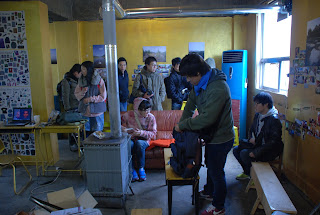In the spring of 2011 graduate students from the GSAKU conceived design proposals for adapting the urban industrial spaces of Mullae village for common public use. The objective of the projects invited community input and critique, in order to establish a base of realistic ideas for a summer 2011 construction workshop.
<Project 1>
The unimpeded decay of industrial buildings becomes template for information gathering in the digital age. Facades function as story tellers and record keepers for visitors, with the assistance of handheld digital devises, the public can learn about the history of Mullae, current events, as well as serving as way finding network. It is the merger of analogue and digital.
author: Junwook Kim
<Project 2>
A survey of the voids and gaps of Mullae reveals opportunity for marginalized re-use. Spaces currently rubbish filled and forgotten are conceived as new public in the form of exhibition, event, socializing and the like. The 'packing' of gaps recalls the present day conditions of steel works and the efficiency of materials handling and storage. The voids create a network of experience for visitors, connected by way of a serendipitous path for free exploration around the village.
authors: Felix Hartz and Frank herzog
<Project 3>
Mullae has contrasting cycles of change, from day to night, when industrial activities end and the night 'work' of artist studios begin. Night time in Mullae is of emptiness, dark with the absence of people and visible activity. This proposal is positioned as an awakening of public accessibility and dialogue between Mullae and surrounding neighborhood after hours. Something that is presently missing in the village; nightlight.
author: Changho Lee
<Project 4>
Existing appurtenant structures establish a system for extension and construction, allowing new impromptu public performance spaces to be realized. By night and weekend times the streets are stages for open performance without the aids of spatial definition. This project contributes to the formation of defined public, deployable at the will of local communities.
author: Gaeun Kim



















































